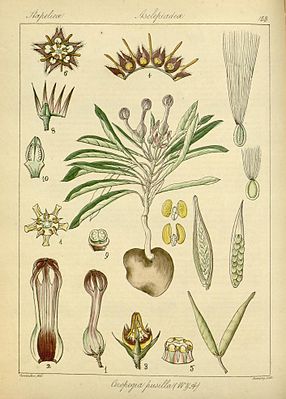Ceropegia pusilla
| Ceropegia pusilla | ||||||||||||
|---|---|---|---|---|---|---|---|---|---|---|---|---|

Ceropegia pusilla (from Wight, Spicilegium Neilgherrense, Plate 153 from 1851) |
||||||||||||
| Systematics | ||||||||||||
|
||||||||||||
| Scientific name | ||||||||||||
| Ceropegia pusilla | ||||||||||||
| Wight & Arn. |
Ceropegia pusilla is a species of plant from the subfamily of the asclepiadoideae (Asclepiadoideae).
features
Vegetative characteristics
Ceropegia pusilla is a perennial , non-twisting plant with a tuberous rhizome. The tuber has a diameter of 2 to 3 cm. The unbranched, hairy shoots grow upright and are only about 5 to 10 cm high. The internodes are quite short. The sessile, hairy leaves or leaf blades are linear and 5 to 8 cm long.
Inflorescence and flowers
The inflorescence is single-flowered and has only a short stalk; the stalks are hairy and 6 to 7 mm long. The five-fold, hermaphrodite flowers are zygomorphic and have a double flower envelope. The corolla is 2.5 to 2.8 cm long and bare on the outside. In the lower part, the five petals are fused to form the corolla tube ( sympetalie ). The lower part of the corolla tube ("Kronkessel") is swollen egg-shaped with a maximum diameter of 5 mm. The crown basin is bare on the inside and merges continuously into the actual crown tube; this has a minimum diameter of 3 mm. Towards the mouth it widens like a funnel to a diameter of 6 mm. The petals are triangular at the base, 9 to 13 mm long and linear. The tips are fused, creating a spherical, cage-like structure. The two lobes of the lobes, separated by a midrib, are bent outward and glabrous. The secondary crown is largely fused cup-shaped and sessile. The tips of the interstaminal secondary crown are narrow triangular and emerge from the upper edge of the fused secondary crown. They stand upright, are 1.5 mm long, incised in the middle and form triangular appendages. The tips of the inner staminal corolla are 2 mm long, linear and slightly club-ending. They stand upright and bend together over the gynostegium .
Fruits and seeds
The paired follicles are 4 cm long and 5 mm in diameter. The seeds are broadly ovate.
Similar species
Ceropegia pusilla , together with Ceropegia noorjahaniae , Ceropegia attenuata , Ceropegia jainii , Ceropegia mahabalei and Ceropegia spiralis, belong to a group of species that all have root tubers, are small and upright, and have linearly shaped leaves. However, they differ in details in the flower morphology.
Geographical distribution
Ceropegia pusilla is common in the Indian states of Karnataka ( Mysore District ), Kerala , Maharashtra , Punjab and Tamil Nadu .
Taxonomy
The taxon was first described in 1834 by Robert Wight and George Arnott Walker Arnott in the "Contributions to the Botany of India". The type material comes from the Piccarah river (not localized) in the Nilgiri Mountains .
The taxon is recognized as a valid taxon by both the Plant List and the Ceropegia Checklist .
supporting documents
literature
- Ulrich Meve: Ceropegia . In: Focke Albers, Ulrich Meve (Hrsg.): Succulents Lexicon Volume 3 Asclepiadaceae (silk plants) . Pp. 61–107, Eugen Ulmer Verlag, Stuttgart 2002. ISBN 3-8001-3982-0 (p. 95)
- Robert Wight: Spicilegium Neilgherrense, or, a selection of Neilgherry plants: drawn and colored from nature, with brief descriptions of each; some general remarks on the geography and affinities of natural families of plants, and occasional notices of their economical properties and uses. Volume 2, 94 pp., Pl. 103–202, Madras, Selbstverlag, 1851 (p. 47/8, Pl. 153) online at www.biodiversitylibrary.org .
- Herbert Huber: Revision of the genus Ceropegia. In: Memórias da Sociedade Broteriana , Volume 12, 1957, pp. 1–203, Coimbra (pp. 53/4)
- R. Kondamudi, V. Vijayalakshmi, KSR Murthy: Induction of morphogenetic callus and multiple shoot regeneration in Ceropegia pusilla Wight and Arn. In: Biotechnology , Volume 9, 2010, pp. 141-148.
- R. Kondamudi, KSR Murthy: Micropropagation and in vitro flowering of Ceropegia pusilla. In: Journal of Tropical Medicinal Plants , Volume 12, No. 1, 2011, pp. 41-47.
Individual evidence
- ^ Robert Wight: Contributions to the Botany of India. 136 pp., London, Parburx, Allen & Co. 1834 Online at Google Books
- ^ Rafael Govaerts (ed.): World Checklist of Selected Plant Families (in review): Ceropegia. Published in: The Plant List. A working list of all plant species. Royal Botanic Gardens Kew, Missouri Botanical Garden, accessed February 5, 2014.
- ↑ Ulrich Meve: Ceropegia Checklist. A guide to alternative names used in recent Ceropegia classification. In: Dennis de Kock, Ulrich Meve: A Checklist of Brachystelma, Ceropegia and the genera of the Stapeliads. International Asclepiad Society, 2007, pp. 83-113.